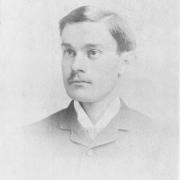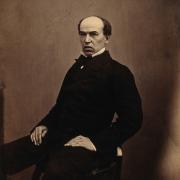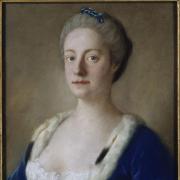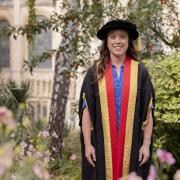Philip Hesketh, who became Dean at Rochester Cathedral this summer, on hidden treasures, strong communities, a calmer Christmas and a bright future

Kent heaved a universal sigh of relief when The Reverend Canon Dr Philip Hesketh was announced as the new Dean of Rochester Cathedral back in February, followed by further rejoicing at his official installation this June.
Dr Hesketh has been filling in as Acting Dean on and off for five years, including the troubled period since the former Dean, Dr Mark Beach, resigned in January 2015. It’s fair to say his time here has coincided with one of the most challenging periods in England’s second-oldest cathedral’s recent history.
He admits: “I had in fact decided to move on, I felt that it was probably fair to do that. I’d been seconded to do another piece of work at Malling Abbey and my face was set towards that path.
“What changed my mind was the extraordinary support from across the county, not just the congregation – who were wonderful – but the whole county. The number of people who wrote and championed me was extremely humbling and in the end I felt well, I owe it to them and to myself to give it a go.”
Phil, who grew up on the Isle of Man, says he wasn’t from a ‘church-y family’ but the seed that grew quietly within him began at his local youth club and led to him studying Divinity at King’s College in London.
Before ordination he worked with the homeless in South London and was actually training to be a counsellor and a therapist until someone asked ‘have you ever thought about being a vicar or a minister?’

“I decided to see what would happen if I did enter the church and got a lot of encouragement – and the counselling tools have been very helpful in giving me an insight into human nature,” he says.
“You step, and take the next step in faith and the next, and you just trust that God has a plan – that is all that is ever required of us, to take that next step. But I don’t think my family would ever have imagined me being the dean of a cathedral – not at all!”
Phil, who went on to serve his curacy in the Diocese of Canterbury, admits: “I was amazed when I was appointed [Dean], but it was just business as usual really, in the same way that we’d been struggling for the last umpteen years. It did feel a little bit weird because a) I couldn’t quite grasp it at first and b) I kept thinking oh – I can’t hand it over any more!
“In the end the most important thing was that I felt I couldn’t walk away when such a lot was in chaos and I genuinely love the community we have here and the cathedral. God clearly had a plan for me.”
We’re chatting in his offices at Garth House having walked the short distance from the cathedral. It took us a while, however, because Phil (as he is universally known) is recognised and greeted wherever he goes and has a word for everyone.
“It can be difficult going to buy a paper,” he laughs, “but that’s a privilege, that everyone wants to stop me and say hello. That’s what we’re all about – being an open, welcoming and friendly church.”

And the hope is that Rochester will be welcoming even more visitors than ever, with the opening of Hidden Treasures, Fresh Expressions (HTFE), an ambitious £5.7m project that focuses on the crypt, library and the ‘hidden collections’ in the cathedral’s ownership.
Sadly Her Royal Highness Sophie Countess of Wessex, who was due to unveil the project in her role as a patron of The Rochester Cathedral Trust, had to cancel her travel plans when they were disrupted by fog, but the rest of us who made it to the opening loved what we saw.
At the very heart of the project is a secure exhibition space within the medieval crypt for the display of the collections; a wealth of texts, books, documents, charters, stonework, embroidery, plate, paintings and historical artefacts, dominated by that precious jewel, the Textus Roffensis, the only existing copy of the first code of English law.
A small donation of £3 per adult to see the exhibition is being asked, but that’s it, stresses the Dean. “Part of the challenge at Rochester is to increase revenue to enable us to have a better and bigger workforce and to keep the cathedral free of charge. We have to look to other income streams to do that because the only people who would be disadvantaged would be the local people. Charging an entrance fee wouldn’t work for a cathedral like Rochester.”
He adds: “If people are coming on tours to see the UK’s top church buildings they will ‘do’ Westminster Abbey, St Paul’s and Canterbury and if they have to pay, they will, because they’ve come a long way and may never come back. We’re not quite yet on that destination map, but with the Textus on permanent show here, and with all our other plans, we may well be in the future. The vision had always been to bring our jewel in the crown back to the place where it was written.”
Not quite complete for the launch day of ‘Hidden Treasures’ (books still in storage boxes), the library is also being repaired and renovated to house the cathedral’s remarkable collection more appropriately and to make this part of the collection more accessible.
“It had its own charm as an Oxbridge-like library, but it was never able to be open to the general public before – and we weren’t looking after the books as well as we would have liked,” admits Phil. “Now we have a dedicated team of volunteers who have done training in the conservation and care of the books and we’re relying on them to train others too.
“For me it’s all about helping the community to ‘own’ these treasures in some way – they are in the care of the dean and chapter but we can involve the local community and that’s why we hope they will have an involvement in what the next exhibition will be, for example.
He adds: “The more visitors we get who can spread the word that Rochester is a really great place to come, the better. Very few cities have a Norman cathedral and castle right next to each other, plus the wonderful High Street and all the Dickensian connections and better transport links following the £26m investment into our new station. The more we can attract people to the cathedral for events the better that is for the local economy.”
Those events include existing ones, such as graduation ceremonies for Kent, Greenwich and Christchurch Universities - “the place is buzzing then, all the families are going into the shops, pubs and restaurants and spending money and the whole community is benefiting” – but also new uses for the transformed main crypt.
Phil hopes the welcoming, versatile space will be hosting everything from concerts and private dinners to jazz nights and art exhibitions. He has exciting plans too for the cathedral’s walled garden, created by former Dean Reynolds Hole, founder of the Royal National Rose Society and organiser of the first specialty rose show in the UK. Phil wants to re-landscape the area as a rose garden featuring Hole’s 122 different varieties, then hopefully join the National Gardens Scheme.
“We’ve been at least four years in this whole process of restoration, delayed because of archaeological problems and difficulties which we could never have been foreseen by anyone and the restrictions we were under because of national guidelines, so we are now nearing that point at last,” he smiles.
There are a few bridges still to cross, including replacing his Canon Precentor who retired this November and the Chapter Clerk (Executive Director) who retires at Christmas, but by Easter he hopes to have a full team.
At times, Phil admits, he has been juggling “two and a half jobs”, but the 52-year-old is looking forward to being able to spend more time with his GP wife Sugina and their grown-up children, the youngest of whom is still at home and in sixth form.
“I hope soon to be able to get some space to stand back and enjoy, reflect and think about what we’ve achieved and what lies ahead. It will also be the first time in three years where we will have most of the building back for our Christmas services, which is wonderful.
“It’s a really exciting time and I regard it as an enormous privilege to have been asked to take on this role.”
Textus Roffensis
The Textus Roffensis (Latin for ‘The Tome of Rochester’) is the only existing copy of the first code of English law and was written in Rochester during the early 1120s.
The medieval manuscript in fact consists of two separate works most probably written by a single scribe, although the glosses to a Latin entry were made by a second hand.
This manuscript, written in Old English and Latin, has been described as one of the most important documents in English history and is not only hugely important in the history of English law and language but is also believed to have influenced the wording of the Magna Carta of 1215 and, later, the American Declaration of Independence of 1776.
Included in the Textus is an account of ceremonies of ordeal for testing innocence using red-hot irons, boiling water and a terrible curse in which the wrong-doer is cursed by the Holy Trinity, archangels and angels; he is cursed living or dying, working or resting, and every part of his body is cursed down to his toenails!
It is rare that a secular book is a textus, and the name given to the Textus Roffensis by the cathedral is considered indicative of the book’s importance during the Middle Ages. The entire volume consists of 235 vellum leaves.
Over the centuries, the Textus Roffensis has been loaned, lost and recovered on several occasions and has been in the custody of a variety of different people and places: it is now finally back at home, in pride of place in the newly transformed crypt of Rochester Cathedral.
Sometime between 1708 and 1718 the book was immersed for several hours in either the River Thames or the River Medway when the ship transporting it overturned; water damage is apparent on a number of pages.
The book was named ‘Britain’s Hidden Treasure’ by the British Library, was the subject of a conference at the University of Kent in 2010 and has been digitised and published online by The University of Manchester’s Centre for Heritage Imaging and Collection Care.



























